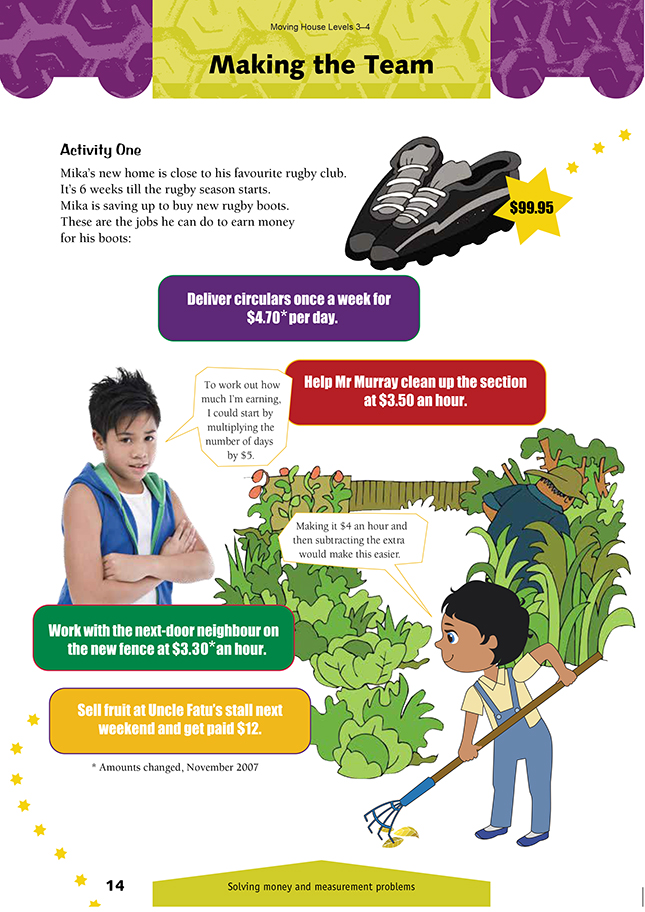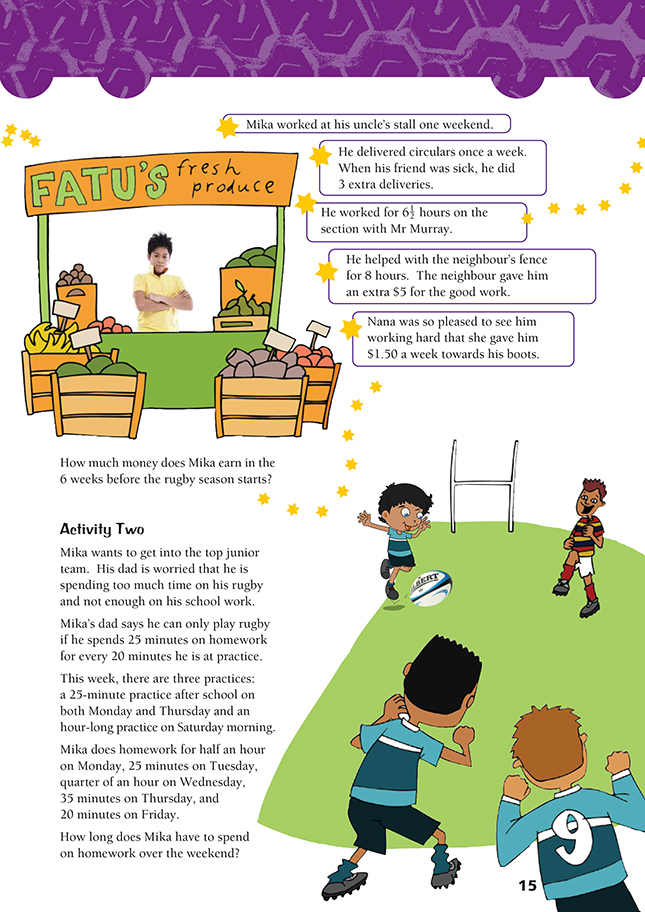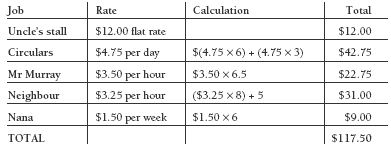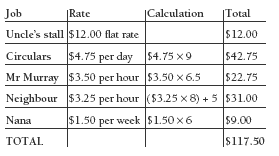This is a level 3 number and measurement activity from the Figure It Out theme series.
A PDF of the student activity is available.
Click on the image to enlarge it. Click again to close. Download PDF (679 KB)
solve money problems using mental strategies
solve problems involving calculations with time
FIO, Levels 3-4, Theme: Moving House, Making the Team, pages 14-15
Activity One
This activity gives students an excellent opportunity to use their mental strategies for addition and multiplication. Mika suggests two such strategies on page 14. You could ask the students to suggest others. For example, to work out how much Mika earns from helping his neighbour with the fence, the students might round the $3.25 down to $3, do the calculation, and then add on the $0.25 × 8. The students could record the amounts Mika earns in a table like the one below. If preferred, the calculation column could be replaced with a strategy column:
Ask the students to estimate how much Mika has earned altogether before they calculate the exact answer. (See the discussion of estimates in the notes for Garage Sale, pages 15–16.)
Activity Two
This problem has a number of elements in it: time spent at rugby practice, time spent on homework, the ratio of homework to practice, and the amount of homework still to be completed.
Students are often confused by problems of this kind; they find it hard to know where to begin, how to pull the details together, and how to judge whether their answer is sensible. Finding the total amount of time already spent on homework (125 minutes) and at rugby practices (110 minutes) is a good first move. The students are likely to find it easiest to work entirely in minutes rather than to try and deal with hours and minutes. “25 minutes on homework for every 20 minutes at practice” can be equally well expressed as “12.5 minutes of homework for every 10 minutes of practice”. Mika spends 11 multiples of 10 minutes on his rugby (110), so he must spend 11 multiples of 12.5 (137.5) on his homework. He has already done 125 minutes, so this will mean he has another 12.5 minutes to do.
For the students who have difficulty understanding ratios, a double number line can be used. For more on these, see Book 7: Teaching Fractions, Decimals, and Percentages, Numeracy Professional Development Projects 2003, (Wellington: Ministry of Education, 2003). This material is available
online at https://nzmaths.co.nz/numeracy-development-projects-books
This activity may well provoke some discussion on the amount and regularity of homework. Is Mika’s dad expecting too much when he says that Mika must do 25 minutes’ homework for every 20 minutes of sports practice, or is this amount too small? A survey of the class could be done to see how much time the students spend on sports and cultural practices, compared with the time they spend on homework.
Links
This activity could form part of a unit on Rights, Rules, and Responsibilities.
Have the students imagine that, in co-operation with a group of friends, they are going to paint a community building in the local area over one weekend. They consider a plan to complete the task effectively, identifying possible conflict situations and taking account of these in their planning.
Suggested achievement objectives are:
Social Studies
• how and why people make and implement rules and laws (Social Organisation, level 3)
• how and why people manage resources (Resources and Economic Activities, level 3)
• how and why people exercise their rights and meet their responsibilities (Social Organisation, level 4).
Answers to Activities
Activity One
The amount Mika earned was $117.50.
Activity Two
12.5 min. (Mika’s practice takes 60 + 25 + 25 = 60 + 50 = 110 min., so he has to do 137.5 minutes of homework this week. He has already done 30 + 25 + 15 + 35 + 20 = 125 min. 137.5 – 125 = 12.5 min.)




